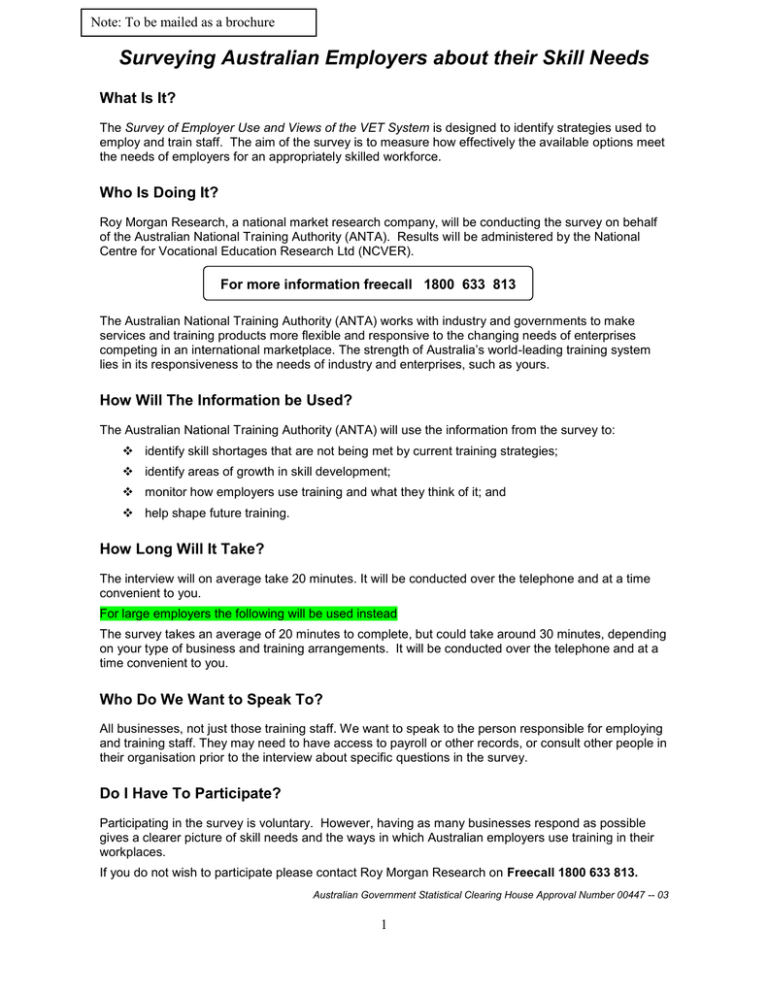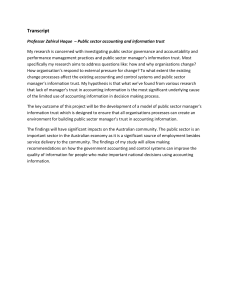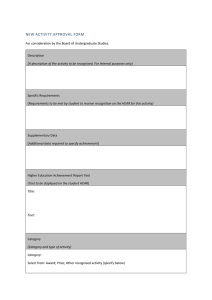33 - Attachment C to Agenda Item 12.3 - SEUV-PAL_additional.doc
advertisement

Note: To be mailed as a brochure Surveying Australian Employers about their Skill Needs What Is It? The Survey of Employer Use and Views of the VET System is designed to identify strategies used to employ and train staff. The aim of the survey is to measure how effectively the available options meet the needs of employers for an appropriately skilled workforce. Who Is Doing It? Roy Morgan Research, a national market research company, will be conducting the survey on behalf of the Australian National Training Authority (ANTA). Results will be administered by the National Centre for Vocational Education Research Ltd (NCVER). For more information freecall 1800 633 813 The Australian National Training Authority (ANTA) works with industry and governments to make services and training products more flexible and responsive to the changing needs of enterprises competing in an international marketplace. The strength of Australia’s world-leading training system lies in its responsiveness to the needs of industry and enterprises, such as yours. How Will The Information be Used? The Australian National Training Authority (ANTA) will use the information from the survey to: identify skill shortages that are not being met by current training strategies; identify areas of growth in skill development; monitor how employers use training and what they think of it; and help shape future training. How Long Will It Take? The interview will on average take 20 minutes. It will be conducted over the telephone and at a time convenient to you. For large employers the following will be used instead The survey takes an average of 20 minutes to complete, but could take around 30 minutes, depending on your type of business and training arrangements. It will be conducted over the telephone and at a time convenient to you. Who Do We Want to Speak To? All businesses, not just those training staff. We want to speak to the person responsible for employing and training staff. They may need to have access to payroll or other records, or consult other people in their organisation prior to the interview about specific questions in the survey. Do I Have To Participate? Participating in the survey is voluntary. However, having as many businesses respond as possible gives a clearer picture of skill needs and the ways in which Australian employers use training in their workplaces. If you do not wish to participate please contact Roy Morgan Research on Freecall 1800 633 813. Australian Government Statistical Clearing House Approval Number 00447 -- 03 1 How Was My Organisation Selected? Your organisation was one randomly selected from the Australian Business Register. The Australian Bureau of Statistics (ABS) has agreed to select a sample of employers from this Register and provide them to the Australian National Training Authority for the purpose of conducting the Survey of Employer Use and Views of the VET System. This is in accordance with legislative guidelines (Subsection 13(1) of the Census and Statistics Act, and Clause 6 of the Statistics Determination). The survey is not conducted by the ABS nor subject to the confidentiality protections of surveys conducted under the authority of the ABS. Are My Answers Confidential? Yes, your privacy is assured. Your contact details and survey responses will remain confidential. Roy Morgan Research will remove all identifying information from the data before providing it to ANTA. Results will be reported as aggregated findings and will not allow individual respondents to be identified. At the completion of the survey all name, address and telephone number details will be returned to the ABS. The Australian Government Statistical Clearing House This survey has been approved by the Australian Government Statistical Clearing House. The approval number is 00447 – 03. You may phone the Statistical Clearing House on (02) 6252 5285 to verify the approval number. How Do I Get the Survey Results? Results will be published and available on the National Centre for Vocational Education Research (NCVER) website in July 2005. See <http://www.ncver.edu.au>. Australian Government Statistical Clearing House Approval Number 00447 -- 03 2 What Do We Want To Know? We will be asking questions about: whether your organisation employs people with formal vocational qualifications or has jobs that require formal vocational qualifications; whether employees have undertaken any nationally recognised training, or unaccredited training in the past year; whether your organisation has apprentices or trainees; any other training provided to employees; whether your organisation is a Registered Training Organisation; and key characteristics of your staff and of your business. We will be asking you what you think about any of this training and your suggestions for improvement. See overleaf for help with what we mean by the terms highlighted above. We will be asking you for some background information on: The total number of employees1 working in, or operating from, this organisation during the last pay period. (Including full-time, part-time and casual employees2, excluding contractors and owners of the business.) The total number who are employed on a permanent and ongoing3 basis. The total number who are employed full-time (35 hours or more per week). The number of employees in the following employee categories (either numbers or percentages): Managers (including general or specialist managers; farmers and farm managers; retail and hospitality managers) Professionals (including professionals in the business, health and education sectors; science, engineering and transport professionals; welfare, legal and media professionals; information and communication technology ( ICT) professionals) Technicians and Tradespersons (including trade workers in the engineering, automotive, and construction industries; skilled agricultural and horticultural workers; science, engineering and ICT technicians) Community and Personal Service Workers (including hospitality workers; protective service workers; carers and aides; health and welfare support workers) Clerical and Administrative Workers (including office managers and program administrators; bookkeepers and loans officers; secretaries, personal assistants, receptionists and inquiry clerks) Sales Workers (including sales representatives, agents, and assistants) Machinery Operators and Drivers (including storepersons; machine and stationary plant operators; mobile plant operators) Labourers (including cleaners; factory process workers; construction and mining labourers; food preparation assistants) It may be easier for you to source this information before we contact you. 1 Employees are wage and salary earners who received pay for any part of the last pay period. This includes: employees on paid or prepaid leave; employees who commenced or terminated employment during the pay period; and employees on workers’ compensation who continue to be paid through the payroll. It excludes person paid solely by commission, without a retainer, wage or salary 2 Casual includes employees who receive some leave entitlements but are employed on a fixed term basis; and employees who may receive a higher rate of pay to compensate for a lack of permanency and entitlements. 3 Employees who are entitled to paid holiday and sick leave. Australian Government Statistical Clearing House Approval Number 00447 -- 03 3 Survey Definitions Registered Training Organisation Refers to a training provider that is registered by a State/Territory Training Authority as nationally recognised for the provision of training and services. Nationally recognised training An accredited program of study that leads to vocational qualifications that are recognised across Australia. This can apply to: a whole course (qualification) or components of a course (units of competency and modules). It is also known as nationally or state accredited training. You can recognise it by a quality stamp that includes the words ‘Nationally Recognised Training’. Only Registered Training Organisations that meet government quality standards can provide nationally recognised training (such as TAFE, private providers and vocational divisions of universities). For the purposes of this survey, nationally recognised training does not include: Training and certifications that may be recognised by your industry, but are not part of the Australian vocational education and training sector. This includes IT certifications such as Microsoft and Cisco, etc. These are typically product specific certifications. University degrees. Questions on nationally recognised training exclude apprenticeships and traineeships as separate questions are asked on this. Formal Vocational Qualifications Qualifications completed that are nationally recognised. These qualifications are delivered by Registered Training Organisations such as TAFE, private providers and vocational divisions of universities. Examples include: Diploma of Accounting, Certificate IV in Retail Management, Certificate III in Hairdressing, Certificate III in Plumbing, Certificate II in Telecommunications, and traditional qualifications such as Electrician or Welder. These qualifications do not include: senior secondary certificates of education (year 12), or qualifications such as bachelor or higher degrees delivered by Universities apprenticeships and traineeships, as this is training towards a vocational qualification. Australian Government Statistical Clearing House Approval Number 00447 -- 03 4 Survey Definitions Apprenticeships and traineeships Refers to people with a formal Training Contract with their employer. The training they undertake as part of their apprenticeship or traineeships is nationally recognised. Apprenticeships and traineeships exist in a wide number of occupations, these include: traditional areas such as electrical, automotive, hairdressing, etc, and non-traditional areas such as tourism and hospitality, information technology, business administration, and health, etc. Examples include: people hired as a traditional apprentice or trainee people still at school in a school based apprenticeship, and existing workers undertaking an apprenticeship or traineeship in the workplace where they are already employed. Unaccredited training Refers to training that does not lead to a nationally recognised qualification. The training activity must have a specified content or predetermined plan designed to develop employment related skills and competencies. Examples include: product or service specific courses (like Certified Novell Engineer, advanced Excel) project management courses workshops on how to deal with customer complaints industry specific or technical training not recognised nationally This training does not include: apprenticeships and traineeships, other nationally recognised training, and study towards a university degree. Australian Government Statistical Clearing House Approval Number 00447 -- 03 5





